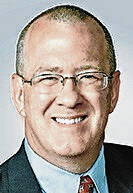It must be said again and again that 48.2 percent of college graduates in the U.S. were working remotely, according to the February 2023 census survey. That number is up slightly from late 2021, suggesting that remote work is here to stay.
It is also important to connect the dots with job creation and remote work. Since 1992, 81 percent of all the net job growth has occurred among college graduates, with the remainder going to those with an associate’s degree or some college training. This trend shows no likelihood of changing and affects all our economic development, tax increases, education and fiscal policy as well.
I want to personalize the experience through the eyes of three 20-something women from the Midwest. Over a short holiday, I stayed with a family with three granddaughters. These cousins graduated college in the past decade. The youngest is 24; the oldest will soon turn 30. They now live on both coasts.
The oldest has worked in a partially remote setting since graduation. At first, she commuted occasionally to work, but after a few months, she was able to perform most of her job at home, using the familiar technology of the computer, Zoom and a phone. Long before COVID, she and her husband both worked remotely, turning spare bedrooms into separate offices.
Her work included technical research and writing about the results of that research. The collecting, processing, analyzing and communicating of data is what about 4 in 10 American jobs do now to some degree or another. These types of tasks can readily be done remotely. The couple mentioned above are now moving to be near family, but in a very expensive city, with good schools and an airport.
The youngest is a military officer in her first assignment. Surprising as it may seem, her command offers remote work one day per week, and she is the third consecutive commander to retain the remote work schedule. My hunch is that across every military career field, a third to half of jobs could have a substantial remote work component. Commanders will need to figure out how to accommodate this or struggle to retain talented young people.
The third cousin works in finance and accounting at a large, privately held firm. She enjoys the position. It is exciting, fairly high-paced, and exposes her to a variety of business problems. It is in a great location, which meant she was willing to take a modestly smaller salary than elsewhere to relocate to the area. She was on the job just a year before COVID hit.
Perhaps foretelling the future, the company handled COVID poorly and confusingly. At one point, they required only the vaccinated workers to come to work, permitting those who chose not to take the vaccine to work remotely. That shockingly poor decision was reversed after only a week, but shows how mindless the workplace rules were at this firm.
Today, they prohibit remote work. Not surprisingly, they have lost a number of employees to firms that allow more flexibility. There’s growing doubt among the younger workers that they’ll have successful hires for these positions, because nearly all the applicants expect remote work options.
The problem is not the human resources staff. They’ve compared productivity during the forced period of remote work with today and found little difference. They’ve also compared position descriptions, salaries and remote work. They think it is less expensive to have some flexibility; the company’s leadership just remains inflexible on the subject.
The experiences of these three women point to the difficult adjustment period we are in today. It is clear that remote work is a huge, popular and growing segment of employment. Some tasks cannot be performed remotely, while others are perfectly suited to it. Some firms might be willing to pay a premium for workers to be on site, or might offer faster promotions to those who occupy offices full time. But, the share of jobs that need to be performed in person are in long-term decline, while remote-compatible occupations grow.
I find the economic incentives pretty conclusively push in one direction — toward more remote work. Businesses will figure this out or fail.
The experiences of these three young women offer insight into the modifications to work, home and family life that remote work now offers. This will be a key demographic to watch in the years ahead.
Michael J. Hicks is the director of the Center for Business and Economic Research and an associate professor of economics in the Miller College of Business at Ball State University. Send comments to [email protected].




